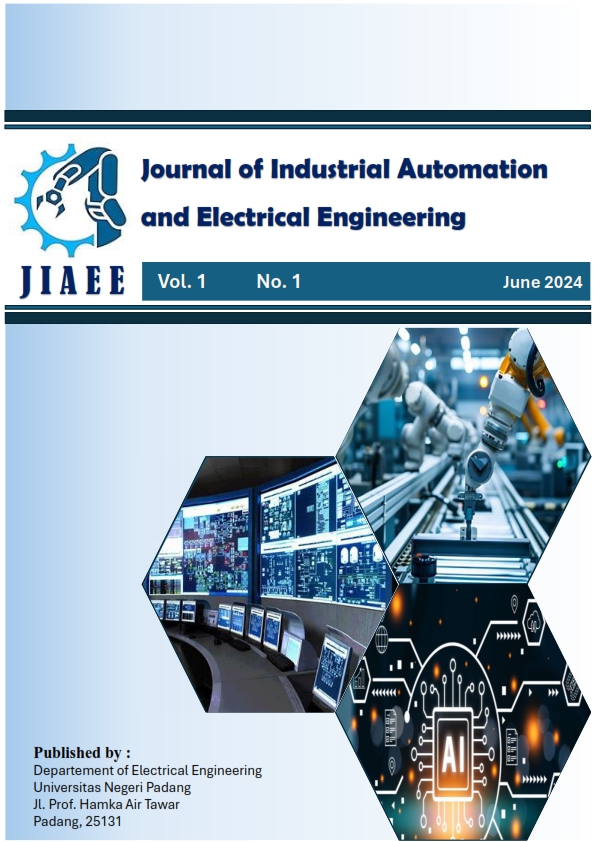Implementation of Maximum power control of Solar Panels using Modified Perturb and Observe Algorithm based on Adaptive Neuro Fuzzy Inference System
Keywords:
Solar panel, Maximum power control, MPPT, ANFIS , Arduino , Boost converterAbstract
In this modern era, the need for renewable energy is increasing, and solar panels are one of the main solutions. To maximize the efficiency of energy extraction from solar panels, a method is needed. Based on the characteristics of voltage and current, the output power of these solar panels changes following changes in irradiation and temperature. Changes in the output power value have a maximum point, where each voltage and current value has a different maximum power point at each change in temperature. For this reason, the Maximum Power Point Tracker (MPPT) method is used to solve this problem by adjusting the solar panel voltage at the maximum point using a power converter. In this study, the MPPT control system will be implemented using a boost converter. This study develops a Maximum Power Point Tracking (MPPT) control system based on the Adaptive Neuro-Fuzzy Inference System (ANFIS), which is developed from conventional perturbation and observation algorithms. The ANFIS-based MPPT control system is implemented using an Arduino microcontroller. The experimental results verify that the proposed ANFIS-based MPPT system has successfully controlled the output power of solar panels at the maximum point
Downloads
References
[1] F. Azizah and M. Yuhendri, “Solar Panel Monitoring and Control System Using Human Machine Interface,” Andalasian International Journal of Applied Science, Engineering and Technology, vol. 2, no. 03, pp. 149–158, 2022, doi: 10.25077/aijaset.v2i03.64.
[2] Erdiwansyah, Mahidin, H. Husin, Nasaruddin, M. Zaki and Muhibbuddin, "A critical review of the integration of renewable energy sources with various technologies," Protection and Control of Modern Power Systems, vol. 6, no. 1, pp. 1-18, January 2021, doi: 10.1186/s41601-021-00181-3.
[3] E. Mustafa, M. Yuhendri, J. Sardi, and D. T. Yanto, “Kendali dan Monitoring Pembangkit Listrik Tenaga Surya Stand Alone Berbasis Human Machine Interface,” JTEIN: Jurnal Teknik Elektro Indonesia, vol. 4, no. 1, pp. 179–189, 2023.
[4] M. Alanazi, M. Mahoor and A. Khodaei, "Co-optimization generation and transmission planning for maximizing large-scale solar PV integration", International Journal of Electrical Power & Energy Systems, vol. 118, pp. 105723, 2020..
[5] R. Mayangsari and M. Yuhendri, “Sistem Kontrol dan Monitoring Pembangkit Listrik Tenaga Surya Berbasis Human Machine Interface dan Internet of Thing,” JTEIN: Jurnal Teknik Elektro Indonesia, vol. 4, no. 2, pp. 738-749–738 – 749, 2023.
[6] P. Holzhey, M. Prettl, S. Collavini, N. Chang and M. Saliba, "Towards Commercialisation with Lightweight, Flexible Perovskite Solar Cells for Residential Photovoltaics," 2023 IEEE 50th Photovoltaic Specialists Conference (PVSC), San Juan, PR, USA, 2023, pp. 1-1, doi: 10.1109/PVSC48320.2023.10359927.
[7] R. Fernandes and M. Yuhendri, “Implementasi Solar Tracker Tanpa Sensor pada Panel Surya,” JTEV (Jurnal Tek. Elektro dan Vokasional), vol. 6, no. 2, pp. 337–343, 2020..
[8] Y. Erkaya, P. Moses, I. Flory and S. Marsillac, "Steady-state performance optimization of a 500 kHz photovoltaic module emulator," 2016 IEEE 43rd Photovoltaic Specialists Conference (PVSC), Portland, OR, USA, 2016, pp. 3205-3208, doi: 10.1109/PVSC.2016.7750257.
[9] M. Yuhendri, A. Aswardi, and A. Ahyanuardi, “Implementasi Pompa Air Tenaga Surya Menggunakan Inverter Boost Satu Fasa,” INVOTEK Jurnal Inovasi Vokasional dan Teknologi, vol. 20, no. 3, pp. 1–10, 2020, doi: 10.24036/invotek.v20i3.813.
[10] Y. Erkaya, P. Moses, J. Flory and S. Marsillac, "Development of a solar photovoltaic module emulator", 42nd IEEE Photovoltaic Specialist Conference, pp. 1-3, 2015.
[11] M. Yuhendri, A. Aswardi, and H. Hambali, “Implementasi Pompa Air Otomatis Tenaga Surya Untuk Rumah Ibadah,” JIPEMAS Jurnal. Inovasi. Hasil Pengabdian Masyarakat, vol. 3, no. 2, p. 166, 2020, doi: 10.33474/jipemas.v3i2.6758.
[12] Y. Erkaya, P. Moses, J. Flory and S. Marsillac, "Development of a solar photovoltaic module emulator", 42nd IEEE Photovoltaic Specialist Conference, pp. 1-3, 2015.
[13] S. Anjeli and M. Yuhendri, “Kendali dan Monitoring Charger Baterai dari Panel Surya Berbasis Human Machine Interface,” JTEIN: Jurnal Teknik Elektro Indonesia, vol. 4, no. 1, pp. 105–114, 2023.
[14] M. N. Bhukya and V. R. Kota, “A novel pandot-neville’s interpolation mppt scheme for maximum PV system energy extraction,” Int. J. Renew. Energy Dev., vol. 7, no. 3, pp. 251–260, 2018, doi: 10.14710/ijred.7.3.251-260.
[15] A. Mudhol and D. P. P. A J, “Design and Implementation of Boost Converter for Photovoltaic Systems,” Ijireeice, vol. 4, no. 2, pp. 110–114, 2016, doi: 10.17148/ijireeice/ncaee.2016.22.
[16] A. Anggawan and M. Yuhendri, “Kendali Tegangan Output Buck Converter Menggunakan Arduino Berbasis Simulink Matlab,” JTEIN: Jurnal Teknik Elektro Indonesia, vol. 2, no. 1, pp. 34–39, 2021, doi: 10.24036/jtein.v2i1.110.
[17] L. Hernández-Callejo, S. Gallardo-Saavedra, and V. Alonso-Gómez, “A review of photovoltaic systems: Design, operation and maintenance,” Solar Energy, vol. 188, no. June, pp. 426–440, 2019, doi: 10.1016/j.solener.2019.06.017.
[18] F. F. Ahmad, C. Ghenai, and M. Bettayeb, “Maximum power point tracking and photovoltaic energy harvesting for Internet of Things: A comprehensive review,” Sustainable Energy Technologies and Assessments, vol. 47, no. June, p. 101430, 2021, doi: 10.1016/j.seta.2021.101430.
[19] D. P. Mishra, R. Senapati, and S. R. Salkuti, “Comparison of DC-DC converters for solar power conversion system,” Indonesian Journal of Electrical Engineering and Computer Science, vol. 26, no. 2, pp. 648–655, 2022, doi: 10.11591/ijeecs.v26.i2.pp648-655
[20] M. Z. Fikri and M. Yuhendri, “Kendali Tegangan Boost Converter Berbasis Adaptive Neuro Fuzzy Inference System ( ANFIS ),” JTEIN: Jurnal Teknik Elektro Indonesia , vol. 4, no. 1, pp. 416–427, 2023.
[21] M. Yuhendri, I. Z. Candra, and C. Dewi, “Kendali Boost converter Berbasis Fuzzy sugeno,” JTEIN: Jurnal Teknik Elektro Indonesia, vol. 4, no. 1, pp. 50–59, 2023.
[22] P. Peri and M. Yuhendri, “Kendali Tegangan Konverter Boost Berbasis Proposional Integral (PI),” Ranah Res. J. Multidiscip. Res. Dev., vol. 5, no. 1, pp. 7–15, 2022, doi: 10.38035/rrj.v5i1.564.
[23] M. Yuhendri and R. Setiawan, “Implementasi DC-DC Boost Converter Menggunakan Arduino Berbasis Simulink Matlab,” JTEIN: Jurnal Teknik Elektro Indonesia, vol. 1, no. 2, pp. 144–149, 2020, doi: 10.24036/jtein.v1i2.64..
[24] A. Alfaris and M. Yuhendri, “Sistem Kendali dan Monitoring Boost Converter Berbasis GUI (graphical user interface) Matlab Menggunakan Arduino,” JTEIN: Jurnal Teknik Elektro Indonesia, vol. 1, no. 2, pp. 266–272, 2020, doi: 10.24036/jtein.v1i2.83.
[25] P. Manoharan et al., “Improved Perturb and Observation Maximum Power Point Tracking Technique for Solar Photovoltaic Power Generation Systems,” IEEE Systems Journal, vol. 15, no. 2, pp. 3024–3035, 2021, doi: 10.1109/JSYST.2020.3003255.
[26] F. Z. El Hamzaoui, T. Abderrahime, and B. D. Taoufiq, “Comparison Between Perturb & Observe, Fuzzy Logic MPPT Technique, and The Artificial Neural Network Techniques at Different Temperature Conditions,” IFAC-PapersOnLine, vol. 58, no. 13, pp. 599–604, 2024, doi: 10.1016/j.ifacol.2024.07.548.
[27] H. Masrepol and M. Yuhendri, “Implementasi MPPT Panel Surya Berbasis Algoritma Perturbasi & Observasi (PO) Menggunakan Arduino,” JTEIN: Jurnal Teknik Elektro Indonesia, vol. 2, no. 2, pp. 162–167, 2021, doi: 10.24036/jtein.v2i2.155.
[28] S. Dorji, D. Wangchuk, T. Choden, and T. Tshewang, “Maximum power point tracking of solar photovoltaic cell using perturb observe and fuzzy logic controller algorithm for boost converter and quadratic boost converter,” Material Today Proceeding, vol. 27, no. xxxx, pp. 1224–1229, 2020, doi: 10.1016/j.matpr.2020.02.144.
[29] S. Necaibia, M. S. Kelaiaia, H. Labar, A. Necaibia, and E. D. Castronuovo, “Enhanced auto-scaling incremental conductance MPPT method, implemented on low-cost microcontroller and SEPIC converter,” Solar Energy, vol. 180, no. March 2019, pp. 152–168, 2019.
[30] E. M. Ahmed, H. Norouzi, S. Alkhalaf, Z. M. Ali, S. Dadfar, and N. Furukawa, “Enhancement of MPPT controller in PV-BES system using incremental conductance along with hybrid crow-pattern search approach based ANFIS under different environmental conditions,” Sustainable Energy Technologies and Assessments, vol. 50, no. November 2021, p. 101812, 2022, doi: 10.1016/j.seta.2021.101812.
[31] S. Necaibia, M. S. Kelaiaia, H. Labar, A. Necaibia, and E. D. Castronuovo, “Enhanced auto-scaling incremental conductance MPPT method, implemented on low-cost microcontroller and SEPIC converter,” Solar Energy, vol. 180, no. October 2018, pp. 152–168, 2019, doi: 10.1016/j.solener.2019.01.028.
[32] M. Yuhendri and G. S. Putra, “Implementasi Sistem Kendali MPPT Panel Surya Berbasis Algoritma Incremental Conductance,” JTEIN: Jurnal Teknik Elektro Indonesia, vol. 1, no. 2, pp. 218–223, 2020, doi: 10.24036/jtein.v1i2.72.
[33] R. Ika, S. Wibowo, and M. Rifa, “Maximum power point tracking for photovoltaic using incremental conductance method,” Energy Procedia, vol. 68, pp. 22–30, 2015, doi: 10.1016/j.egypro.2015.03.228.
[34] M. Fathi and J. A. Parian, “Intelligent MPPT for photovoltaic panels using a novel fuzzy logic and artificial neural networks based on evolutionary algorithms,” Energy Reports, vol. 7, pp. 1338–1348, 2021, doi: 10.1016/j.egyr.2021.02.051.
[35] M. Yuhendri, M. Ashari, and M. H. Purnomo, “A novel sensorless MPPT for wind turbine generators using Very Sparse Matrix Converter based on hybrid intelligent control,” International Review of Electrical Engineering, vol. 10, no. 2, pp. 233–243, 2015, doi: 10.15866/iree.v10i2.2980.
[36] H. Khabou, M. Souissi, and A. Aitouche, “MPPT implementation on boost converter by using T–S fuzzy method,” Mathematics and Computers in Simulation, vol. 167, pp. 119–134, 2020, doi: 10.1016/j.matcom.2018.05.010.
[37] L. F. Giraldo, J. F. Gaviria, M. I. Torres, C. Alonso, and M. Bressan, “Deep reinforcement learning using deep-Q-network for Global Maximum Power Point tracking: Design and experiments in real photovoltaic systems,” Heliyon, vol. 10, no. 21, p. e37974, 2024, doi: 10.1016/j.heliyon.2024.e37974.
[38] M. S. Arifin, “A fuzzy logic based power management system for a hybrid microgrid,” Indonesian Journal of Electrical Engineering and Informatics (IJEEI), vol. 9, no. 2, pp. 334–345, 2021, doi: 10.52549/ijeei.v9i2.2627.
[39] M. Yuhendri, M. Ashari, and M. H. Purnomo, “Adaptive Type-2 Fuzzy Sliding Mode Control for grid-connected wind turbine generator using Very Sparse Matrix Converter,” International Journal Renewable Energy Research, vol. 5, no. 3, 2015.
[40] Y. Bouazzi, Z. Yahyaoui, and M. Hajji, “Deep recurrent neural networks based Bayesian optimization for fault diagnosis of uncertain GCPV systems depending on outdoor condition variation,” Alexandria Engineering Journal, vol. 86, no. December 2023, pp. 335–345, 2024, doi: 10.1016/j.aej.2023.11.053.
[41] A. Lindo and M. Yuhendri, “Sistem Kendali Daya Maksimum Panel Surya Berbasis Fuzzy Logic Controller,” JTEIN: Jurnal Teknik Elektro Indonesia, vol. 3, no. 1, pp. 102–110, 2022, doi: 10.24036/jtein.v3i1.207.
[42] H. A. Mosalam, R. A. Amer, and G. A. Morsy, “Fuzzy logic control for a grid-connected PV array through Z-source-inverter using maximum constant boost control method,” Ain Shams Engineering Journal, vol. 9, no. 4, pp. 2931–2941, 2018, doi: 10.1016/j.asej.2018.10.001.
[43] M. Yuhendri, M. Muskhir, and Taali, “A novel optimum tip speed ratio control of low speed wind turbine generator based on type-2 fuzzy system,” Bulletin of Electrical Engineering and Informatics, vol. 8, no. 4, pp. 1189–1197, 2019, doi: 10.11591/eei.v8i4.1450.
[44] C. R. Çırak and H. Çalık, “Hotspots in maximum power point tracking algorithms for photovoltaic systems – A comprehensive and comparative review,” Engineering Science and Technology, an International Journal, vol. 43, 2023, doi: 10.1016/j.jestch.2023.101436.
[45] H. Li, D. Yang, W. Su, J. Lü and X. Yu, "An Overall Distribution Particle Swarm Optimization MPPT Algorithm for Photovoltaic System Under Partial Shading," IEEE Transactions on Industrial Electronics, vol. 66, no. 1, pp. 265-275, Jan. 2019, doi: 10.1109/TIE.2018.2829668.
[46] M. Yuhendri, M. Ashari, and M. H. Purnomo, “Maximum Output Power Tracking of Wind Turbine Using Intelligent Control,” TELKOMNIKA (Telecommunication Comput. Electron. Control., vol. 9, no. 2, p. 217, Aug. 2011, doi: 10.12928/telkomnika.v9i2.690.
[47] D. Shetty and J. N. Sabhahit, “Grey wolf optimization and incremental conductance based hybrid MPPT technique for solar powered induction motor driven water pump,” International Journal of Renewable Energy Development, vol. 13, no. 1, pp. 52–61, 2024, doi: 10.14710/ijred.2024.57096.
[48] N. Priyadarshi, S. Padmanaban, J. B. Holm-Nielsen, F. Blaabjerg and M. S. Bhaskar, "An Experimental Estimation of Hybrid ANFIS–PSO-Based MPPT for PV Grid Integration Under Fluctuating Sun Irradiance," IEEE Systems Journal, vol. 14, no. 1, pp. 1218-1229, March 2020, doi: 10.1109/JSYST.2019.2949083.
[49] M. Yuhendri and Aslimeri, “Optimum torque control of direct driven wind energy conversion systems fed sparse matrix converter,” Journal of Electrical Systems, vol. 14, no. 3, 2018
[50] J. Dadkhah and M. Niroomand, "Optimization Methods of MPPT Parameters for PV Systems: Review, Classification, and Comparison," Journal of Modern Power Systems and Clean Energy, vol. 9, no. 2, pp. 225-236, March 2021, doi: 10.35833/MPCE.2019.000379.
[51] M. Etezadinejad, B. Asaei, S. Farhangi and A. Anvari-Moghaddam, "An Improved and Fast MPPT Algorithm for PV Systems Under Partially Shaded Conditions," IEEE Transactions on Sustainable Energy, vol. 13, no. 2, pp. 732-742, April 2022, doi: 10.1109/TSTE.2021.3130827.
[52] I. F. Sanul and M. Yuhendri, “Sistem Kendali MPPT Panel Surya Dengan Menggunakan Algoritma Jaringan Saraf Tiruan,” JTEIN: Jurnal Teknik Elektro Indonesia, vol. 4, no. 1, pp. 345–352, 2023.
[53] R. B. Bollipo, S. Mikkili and P. K. Bonthagorla, "Hybrid, optimal, intelligent and classical PV MPPT techniques: A review," CSEE Journal of Power and Energy Systems, vol. 7, no. 1, pp. 9-33, Jan. 2021, doi: 10.17775/CSEEJPES.2019.02720







